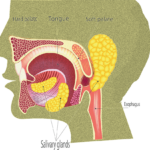 The mouth, or oral cavity, is part of both the digestive and respiratory systems. It is composed of various parts that work together to help with functions such as chewing (mastication) and speaking.1,2 The parts of the mouth include:
The mouth, or oral cavity, is part of both the digestive and respiratory systems. It is composed of various parts that work together to help with functions such as chewing (mastication) and speaking.1,2 The parts of the mouth include:
Lips: Two structures that transition from skin to mucous membrane; they are the entrance to the mouth.3,4
Cheeks: The walls of the mouth; between the outer layer of skin and inner layer of mucous membrane are buccinator muscles, which are involved in chewing and speaking.4
Oral vestibule: The area between the lips/cheeks and gums/teeth.3,4
Oral cavity proper: The area from the gums/teeth to the opening between the oral cavity and throat (fauces).4
Gums: Tissue that lines the bone that contains the teeth (alveolar arch), surrounding the teeth.3
Teeth: Organs that are similar to bones.4 Most people have two sets of teeth during their lifetime, 20 primary teeth as children and 32 permanent (secondary) teeth in adulthood.1,3
Palate: The roof of the oral cavity, which separates the oral and nasal cavities. The anterior portion, known as the hard palate, is supported by bone, whereas the posterior portion, the soft palate, is supported by skeletal muscle and connective tissue. The uvula hangs from the back of the soft palate.1
Tongue: The muscle involved in mastication, swallowing, and speech. Papillae on the tongue’s surface provide the sense of taste (taste buds),4,5 as well as friction to help the food move within the mouth.1,4
Salivary glands: Various major and minor salivary glands throughout the mouth secrete saliva to moisten the mouth and help breakdown food.3,4
Digestive System
The digestive process begins when food enters the mouth. The lips can sense the temperature and texture of food.1,6 During mastication, the teeth tear, grind, and breakdown food into smaller pieces,4,5 while the lips and cheeks work together to keep food in the mouth.1,4 The tongue is responsible for various processes during mastication, including, moving/manipulating food for chewing, pressing food against the palate to form the bolus (mixture of food and saliva), and positioning the bolus in the back of the throat to be swallowed.4–6 In addition to providing a sense of taste, taste buds can stimulate saliva secretion.4
Hundreds of minor salivary glands are located in the lips, cheeks, tongue, and palate;7 these glands ensure that the mouth stays moist through constant secretion of saliva.4 Lingual glands on the tongue secrete lingual lipase, an enzyme that is necessary for the breakdown of triglycerides later in the digestive process.4 There are three pairs of major salivary glands: the submandibular glands, located below the jaw; the sublingual glands, located below the tongue; and the parotid glands, located in front of and below the ears.4,7 Saliva mostly consists of water, but also contains mucus, enzymes, antibodies, proteins, and ions.4,6–8 In addition to lubrication, saliva has a buffering capacity to maintain a steady pH level, and it strengthens teeth and protects against tooth decay.8 The antibacterial agents in saliva, notably immunoglobulin A and lysozyme, keep the mouth healthy. Saliva contains the enzyme amylase, which aids in digestion by breaking down carbohydrates into sugars.4,8
Respiratory System
The mouth plays a role in the respiratory system by bringing air to the lungs; it brings in more air more quickly than the nose, which allows the body to use it faster. However, the mouth does not contain a filtration system like the nose does, and constant mouth breathing can dry the gums and lead to xerostomia (dry mouth).2
Speech
The tongue, lips, palate, upper teeth and gum ridge, and uvula play a role in articulation.9 The tongue presses against the palate or teeth and the lips move in order to formulate speech.5,9
Conditions and Care
Some oral health conditions include infections (e.g., herpes, tonsillitis, candidiasis), xerostomia, periodontal disease, tooth decay, tooth abscess, halitosis (bad breath), cleft lip, cleft palate, ulcers, leukoplakia, swollen salivary glands, and oral cancer.2,3 Practicing proper oral hygiene, which includes brushing your teeth twice a day and flossing daily and regularly visiting the dentist, can help protect against many oral health conditions.2
Sources
- National Cancer Institute SEER Training Modules. Mouth. https://training.seer.cancer.gov/anatomy/digestive/regions/mouth.html. Accessed 22 Sep 2023.
- Cleveland Clinic. Mouth: anatomy, function, and care. Reviewed 10 Aug 2023. https://my.clevelandclinic.org/health/body/21765-mouth. Accessed 22 Sep 2023.
- Better Health Channel. Mouth. Reviewed 31 Oct 2012. https://www.betterhealth.vic.gov.au/health/conditionsandtreatments/mouth. Accessed 22 Sep 2023.
- Biga LM, Bronson S, Dawson S, et al. 23.3 The mouth, pharynx, and esophagus. In: Anatomy & Physiology. OpenStax/Oregon State University; 26 Sep 2019. https://open.oregonstate.education/aandp/chapter/23-3-the-mouth-pharynx-and-esophagus/. Accessed 22 Sep 2023.
- Kamrani P, Sadiq NM. Anatomy, head and neck, oral cavity (mouth). Updated 14 Aug 2023. In: StatPearls [Internet]. StatPearls Publishing; 2023.
- Smith Haghighi A. What does the mouth do in the digestive system? Medical News Today. 4 Apr 2023. https://www.medicalnewstoday.com/articles/what-does-the-mouth-do-in-the-digestive-system#chemical-digestion. Accessed 22 Sep 2023.
- National Institute of Dental Health and Craniofacial Research. Saliva & salivary gland disorders. Reviewed May 2023. https://www.nidcr.nih.gov/health-info/saliva-salivary-gland-disorders. Accessed 22 Sep 2023.
- Ngamchuea K, Chaisiwamongkhol K, Batchelor-McAuley C, Compton RG. Chemical analysis in saliva and the search for salivary biomarkers – a tutorial review. Analyst. 2017;143(1):81–99.
- The Editors of Encyclopedia Britannica. Articulation. Encyclopedia Britannica. https://www.britannica.com/topic/articulation-speech. Accessed 22 Sep 2023.





